Happy Birthday Ficus
/0 Comments/in Design, Gardening, Houseplants/by Lee Reich
Another Year, Another Pruning and Re-potting
I’d like to say it was the birthday of my baby ficus except I don’t know when it was actually born. And since it was propagated by a cutting, not by me, and not from a seed, I’m not sure what “born” would actually mean. No matter, I’m having its biannual celebration marking its age and its growth.
Just for reference, baby ficus is a weeping fig tree (Ficus benjamina), a tree that with age and tropical growing conditions rapidly soars to similar majestic proportions as our sugar maples. That is, if unrestrained in its development.
Baby ficus (FIGH-kus) began life here as one of three small plants rooted together in a 3 inch pot and purchased from a discount store. (Weeping figs are common houseplants because of their beauty and ability to tolerate dry air and low light indoors.) Eight years later, it’s about 4 inches tall with a wizened trunk and side branches that belie its youth. 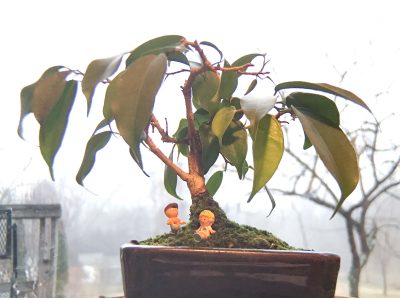 Moss carpeting the soil beneath it and creeping up the trunk complete the picture. I’ve made and am making baby ficus into a bonsai.
Moss carpeting the soil beneath it and creeping up the trunk complete the picture. I’ve made and am making baby ficus into a bonsai.
The biannual celebration begins with my clipping all the leaves from the plant. Baby ficus’ diminutive proportions keep this job from being tedious.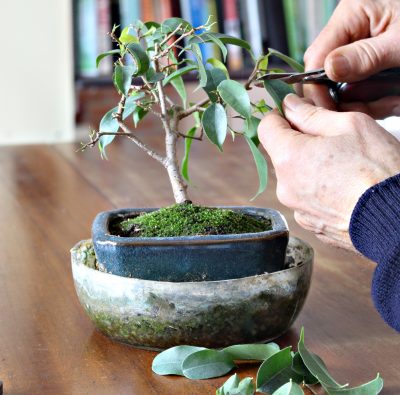 Clipping the leaves accomplishes two goals. First, plants lose water through their leaves so removing leaves reduces water loss (important in consideration of the next celebratory step).
Clipping the leaves accomplishes two goals. First, plants lose water through their leaves so removing leaves reduces water loss (important in consideration of the next celebratory step).
And second, clipping the leaves reduces the size of leaves in the next flush of growth, keeping the in proportion to the size of the plant. Leaves on an unrestrained weeping fig grow anywhere from 2 to 5 inches long, which would look top heavy on a plant 4 inches tall.
The next step is to tip the plant out of its pot so I can get to work on its roots. The pot is only an inch deep and 4 inches long by 3 inches wide, so obviously can’t hold much soil. 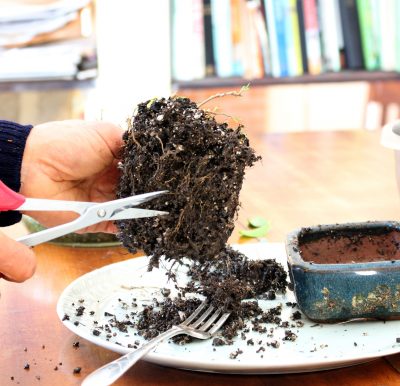 Baby ficus gets all water and its nourishment from this amount of soil. Within 6 months or so, roots thoroughly fill the pot of soil and have extracted much of the nourishment contained within.
Baby ficus gets all water and its nourishment from this amount of soil. Within 6 months or so, roots thoroughly fill the pot of soil and have extracted much of the nourishment contained within.
So the roots need new soil to explore, and space has to be made for that new soil. That space is made by cutting back the roots. (Less roots means less water up into the plant, which is why I began by reducing water loss by clipping off all the leaves). I tease old soil out from between the roots and with a scissors shear some of them back.
Next, I put new potting mix into the bottom of the pot, just enough so the plant can sit at the same height as it did previously. Any space near the edges of the pot gets soil packed in place with a blunt stick. Throughout this repotting, I manage to preserve more or less intact the moss growing at the base of the plant.
Now the plant needs its stems pruned. After all, I don’t want the plant growing larger each year, just more decorative as the trunk and stems thicken and age. Pruning involves some melding of art and science. As far as art, I’m aiming for the look of a mature, picturesque tree. 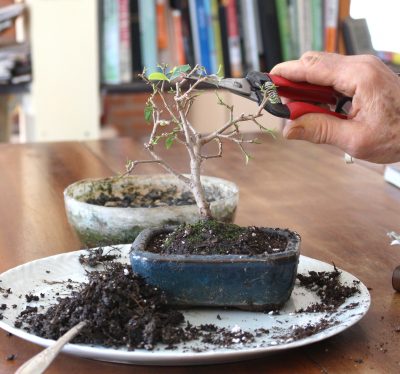 As far as science, I shorten stems where I want branching, usually just below the cut. Where I don’t want branching but want to decongest stems, I remove a stem or stems right to their base. I also remove any broken, dead, or crossing branches unless, of course, leaving them would be picturesque.
As far as science, I shorten stems where I want branching, usually just below the cut. Where I don’t want branching but want to decongest stems, I remove a stem or stems right to their base. I also remove any broken, dead, or crossing branches unless, of course, leaving them would be picturesque.
Finally, a thorough watering settles the plant into its refurbished home. Until new leaves unfold and new roots begin to explore new ground, water needs for baby ficus are minimal.
Oh, one more step. I stand back and take an admiringly look at baby ficus in its eighth year.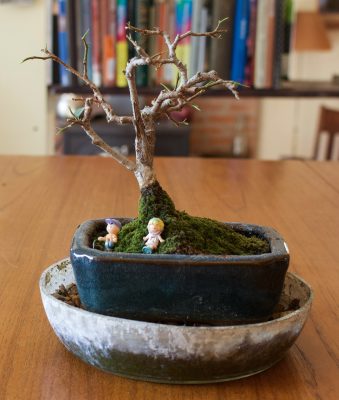
Fahrenheit Obsession
/11 Comments/in Gardening/by Lee ReichA Pillbox Relaxes Me
A little blue pillbox has solved my sleep problems.
I’ve touted the abundance of fresh figs I gather in summer and fall from my greenhouse, and the salad greens in winter. Not to mention the transplants for the garden in spring and summer.
All this has come at a price: sleep. In winter I often worry that something will go awry with the heater that keeps greenhouse temperatures from dropping below freezing, threatening the life of the in-ground fig trees and the salad greens.
And things have occasionally gone awry. One winter, the gas company didn’t deliver the gas for the propane heater on time. Another winter the pilot light kept going out on the heater. Another winter there was an interruption in electrical service, just a small amount of which is needed for the thermostat.
From the warmth of my home, how could I know if my plants were suffering so that I could take action? I set up a remote monitor with a secondary thermostat and a light bulb; if the greenhouse temperature drops below 35° F., I know it because the light goes on. Of course, I have to look outside at the greenhouse occasionally. And if I’m in bed on some cold winter night . . . a bicycle mirror mounted on the window lets me know if the light is on without my even having to lift my head. Of course, all bets if I am asleep, or if electrical service is interrupted.
Which brings me back to the blue pillbox. It’s filled with electronics, not pills.
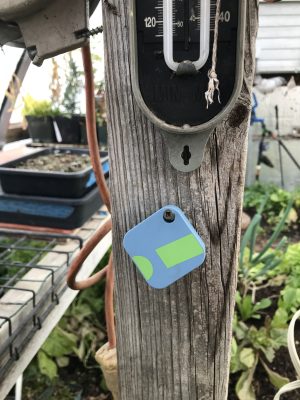
SensorPush in greenhouse
This device, sold as SensorPush, hangs on a nail in my greenhouse and continuously records temperature and humidity therein. No need for me to go to the greenhouse to communicate with it, though. It beams the information via bluetooth to my smartphone.
Better still, I can retrieve the information if my phone is beyond the approximately 325 foot bluetooth range with the help of the SensorPush Gateway. The Gateway connects via wi-fi to put the temperature and humidity information on the web and then on to my smartphone. From anywhere that I have cell service.
The Gateway connects via wi-fi to put the temperature and humidity information on the web and then on to my smartphone. From anywhere that I have cell service.
And even better, SensorPush can also alert my smartphone (and, hence, me) should the greenhouse temperature ever drop below (or above) whatever low (or high point) I set it at. The Gateway does require electricity. But Central Hudson has an alert feature to notify me, again via my increasingly smart smartphone, if the electrical service has been interrupted.
Checking Out the Weather, Continuously
I’m going to get another SensorPush to hang outdoors on one of the garden fenceposts. Knowing temperatures and humidity out in the garden is very useful to anyone who grows tree fruits.
Spring frosts threaten blossoms of fruit trees that bloom early in the season. Most threatened are apricots and peaches, but a season’s crop of apples, pears, cherries, or plums could also be snuffed out by a dramatic drop temperature. 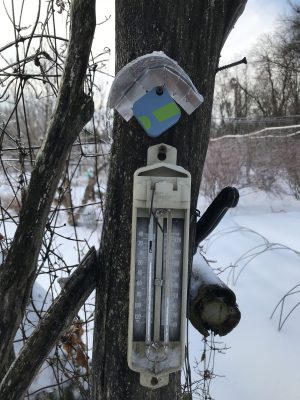 Just how much cold kills these blossoms depends on the kind of fruit and the stage of blossoming. For instance, when apricot flower buds have just begun to swell and separate, they’ll laugh off cold down to zero degrees F. Once the petals begin to spread, the buds are killed at 19°F. When petals fall, 24° is lethal.
Just how much cold kills these blossoms depends on the kind of fruit and the stage of blossoming. For instance, when apricot flower buds have just begun to swell and separate, they’ll laugh off cold down to zero degrees F. Once the petals begin to spread, the buds are killed at 19°F. When petals fall, 24° is lethal.
So a SensorPush out in the garden would at the very least tell me whether to expect a crop from any of these tree fruits. Or to take action, like running outside to drape a blanket over a tree.
Knowing temperature and humidity can also predict the likelihood of disease. The spores of brown rot disease of plums, for instance, grow best in rainy weather with temperatures in the mid-70s during bloom or as fruit is ripening. Longer periods of wetness are needed at lower temperatures. Once again, such information can be used for prediction or action, in the latter case a preventative spray of sulfur, for example. (Sulfur, a naturally mined mineral, is an organically approved fungicide.)
A final nice feature of SensorPush is that it keeps records of the data it collects. The graphs it generates can be viewed on my smartphone or downloaded to a computer.
Now . . . if only I had an expensive art collection, a wine cellar, a reptile cage, or something else that needed close monitoring of temperature and humidity, I could justify another SensorPush.
Okay, now I’m going back to sleep, soundly.
Valentinic Communiqués
/3 Comments/in Flowers/by Lee ReichBe Careful What You Say/Send/Deliver
As you look online or peruse the seed and nursery catalogues that turn up in your mailbox, take note of those flowers that you might need to grow and preserve for the purpose of delivering messages for Valentines Day next year. For this year, fresh flowers from a florist will do. The Household Guide, or Practical Helps for Every Home (including Home Remedies for Man and Beast) written by Professor B. G. Jefferis, M.D., Ph.D. in 1893 serves as my reference on the language of flowers.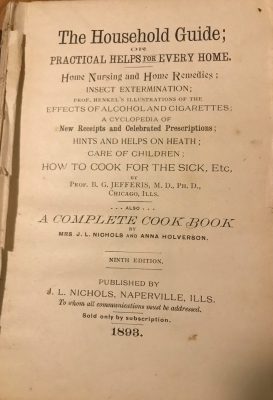
“Say it with flowers,” suggests the florist of today. Before presenting flowers, make sure you know what you are saying?
Everyone knows that a rose represents an expression of romantic love. But watch out! According to my little book, you had better heed what kind of rose you pull out from behind your back to present to the one you love. In the early stages of a romance, a moss rose (Rosa centifolia mucosa) such as Alfred de Dalmas or Général Kléber in bud might be an appropriate symbolic confession of love. Or you might use any white rose, which says something a little different: “I am worthy of you.” If you feel your lover glancing astray, a yellow rose will express your jealousy. For the relationship becoming stagnant, Doctor Jefferis prescribes Madame Hardy, York and Lancaster, or some other damask rose (Rosa damascena), meaning “beauty ever new.”
There is no better way to cement that budding romance than with an outstretched hand clasping a four-leaf clover, the plant that says “be mine.” Even in summer, you might spend all day on hands and knees looking for a four-leaf clover, and still never find one. Much more convenient is to substitute an oxalis leaf.  Though not related to clover, oxalis (Oxalis deppei, sometimes called the shamrock plant) leaves are dead ringers for clover leaves — except that all oxalis leaves have four leaflets. And better still, oxalis can be grown as a houseplant, affording you “four-leaf” clovers for year-round proclamations of affection.
Though not related to clover, oxalis (Oxalis deppei, sometimes called the shamrock plant) leaves are dead ringers for clover leaves — except that all oxalis leaves have four leaflets. And better still, oxalis can be grown as a houseplant, affording you “four-leaf” clovers for year-round proclamations of affection.
Later, if your amorous relationship turns sour, it is time to send (perhaps best not to hand-deliver this message) sweet-pea flowers. The message: depart. Sow sweet-pea early in the spring — April first around here, if you are in a rush for this message. And if you’re really in a rush, soak the seeds for 24 hours before planting.
Sentiments represented by other flowers may or may not be obvious. Forget-me-not, as expected, means just that. You might have suspected that witch-hazel represents a spell and that dead leaves of any kind represent sadness. But did you know that pansy represents thoughts . . . red clover industry . . . ferns fascination . . . golden rod caution . . . and orange blossoms chastity? One can only imagine what “dangerous pleasures” meant in 1893, but they were represented by the fragrant tuberose.
Dr. Jefferis further instructs us that flowers can be combined for greater depth of meaning. For example, a bouquet of mignonettes and colored daisies means “your qualities surpass your charms of beauty.” Yellow rose, a broken straw, and ivy together mean “your jealousy has broken our friendship.” And, a white pink, canary grass, and laurel” mean that “your talent and perseverance will win you glory.”
One caution when presenting flowers in person: Present them upright because an upside down presentation conveys the opposite meaning. Unless that is your intent.

